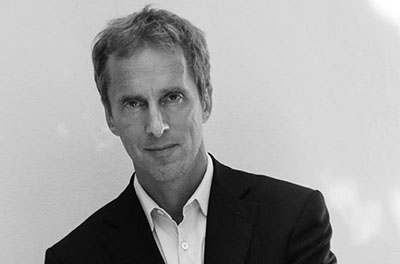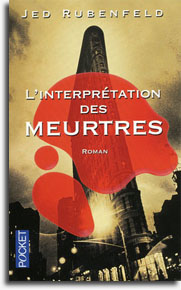Lire l'interview en français
Hello Jed Rubenfeld, could you tell us more about yourself and your career?Hello, and thank you for this interview. Where to start? I’m a professor at Yale Law School, a failed actor, a pretty well-known expert on constitutional law, and an accidentally successful novelist. I got massively lucky with my first novel, The Interpretation of Murder, which was translated into more than 30 languages and sold well over a million copies worldwide. I live in New Haven, Connecticut with my wife, Amy Chua, and my two brilliant daughters, one of whom we will be losing to college this year. Amy, who is also an author, and I always keep our family matters very private. So as to our parenting decisions, for example, or any other aspects of our family drama, I couldn’t possibly allow the slightest public glimpse into that.
Sigmund Freud is one the main characters of The interpretation of murder and he is also in your novel The death instinct. Where from comes to you this interest for this celebrity and in a large way for psychoanalysis?
Your new novel The death instinct has just been published in France (Fleuve Noir), could you present it to us?The Death Instinct (L’Origine du Silence) is a love story, an adventure story, and in its historical basis a completely true story. It opens with a real event: on a clear September morning, the United States is hit by the deadliest, most massive terrorist attack in the country’s history, targeting the nation’s financial center in lower Manhattan. But it’s not September 11, 2001; it’s September 16, 1920. Astonishingly, nearly no one, even in the US, remembers the Wall Street bombing of 1920, despite its uncanny similarities to 9/11 and the lessons it might have taught us. I myself knew nothing about it until a few years ago. To this day, we don’t know with certainty who was behind the Wall Street bombing. My book tells a story about the secret truth behind this attack – and why its perpetrators were never caught. At the same time, it tells a story about the present day – about corruption, war, and what Freud called the death instinct (la pulsion de mort).
Sigmund Freud – for some, the name conjures up the “Oedipus complex,” female anatomical “envy,” and other notorious sexual theories. But in fact, putting aside all such theories, we still live and breathe in a world of ideas that Freud bequeathed us. The idea of the unconscious; of deep fears and desires that motivate us without our knowledge; of learning about ourselves by recovering our childhood; of achieving mental health by “talking things out.” For better or worse, we take all these ideas for granted today, and they are all deeply Freudian.
When reading your novels, we noticed the huge research work that you had to do before writing them and that allow you to restore in your novels the atmosphere of this period. How do you work?
Thank you – the historical accuracy of my books is something I work hard on and take pride in. The Death Instinct includes many scenes and events that might seem incredible – except that they’re completely historically accurate. For example, a man named Ed Fischer, a four-time U.S. Open tennis champion, sends postcards to a half-dozen friends before the bombing warning them that a gigantic bomb is going to go off on Wall Street on the day in question. This is like someone sending out a half-dozen postcards before 9/11 warning friends to get out of the World Trade Center because airplanes were going to fly into them on September 11. Do you know what the U.S. government did with Fischer? They had him declared insane and locked up in a mental institution. To this day, historians cannot understand how Fischer could possibly have known about the attack and assert that he “just got lucky.” If I had made all this up, readers would hardly have believed it. But it’s true, and my story imagines a secret behind the mysterious Fischer.
In general, getting the historical places and events right is not the hardest part. There’s plenty of historical material out there; an author just has to put in the enormous amount of time required to go through it – reading books, searching newspaper archives, digging up old photographs, traveling to get a first-hand view. Getting the people right – the historical figures – is much more difficult. I find letters very useful, when they exist, to get a sense of how the person used language – or how others felt about him.
Younger and Littlemore are fictional characters. How are they born and have you some things in common with them?
Their relation to me is simple. I wish I were more like Littlemore; in fact I am more like Younger. The book is set in 1920. Younger, who fought in the First World War, one of the bloodiest, deadliest and most pointless wars in human history, returns from that war toughened, unafraid, skeptical – a man of action who casts a cold eye on both life and death. But then he falls in love, despite himself. Maybe if you crossed Humphrey Bogart from Casablanca, or Clint Eastwood, with a Harvard-trained surgeon, you’d have Stratham Younger. Littlemore is a particular kind of American hero that I grew up with – a Jimmy Stewart type, if you’ll forgive another Hollywood reference. He is honest, street-smart, independent, idealistic; he hates corruption and the abuse of power. By nature he’s an optimist, but he too has secret troubles and self-doubts.
What pushed you to use in your novels historical facts and real people?
I guess I did it because I like reading historical novels myself. My aim is for readers of The Death Instinct to feel as if they’re living in New York City in 1920, hearing its voices, seeing its great buildings, learning about a time and place they could never actually visit.
In your novels, you skillfully combine the detective/police and historical genres, what are your influences?
For crime and detection, Graham Green and Conan Doyle are the masters (in English), as far as I’m concerned. For adventure and replicating a historical period, I take inspiration from Patrick O’Brian, author of a very popular series of seafaring novels set mostly in the Napoleonic wars.
Your two novels The interpretation of murder and The death instinct, take place at the beginning of the 20th century, would you consider writing a book which would take place in the present time?Well, first I have to finish the Younger-Littlemore series. There will be seven in all, each concentrating on a different decade in American history. I’ve just completed book three, set in the Great Depression, in which our two heroes take to the stage as tap-dancing vaudevillians to support their starving families. In book seven, Younger and Littlemore, in their eighties, will crawl through the napalm-ridden jungles of Vietnam while solving the true mystery behind Watergate. I’m just joking, of course. The serious answer is yes, I would very much like to write something set in the present time.
Your novels are translated in several countries. How do an author feel when his books travel around the world?
It’s a great honor. Translation can be difficult, of course. I remember when Japan was first publishing a book of mine. It was an academic book and in English, the title was “The Right of Privacy.” Apparently the title gave the Japanese translators a very difficult time; they told me that Japanese had no word for “privacy.”
Thank your very much Jed Rubenfeld, you have the last word.Thank you. I just hope you’ll forgive my poor French when I come to Paris this September for the French publication of L’Origine du Silence.



